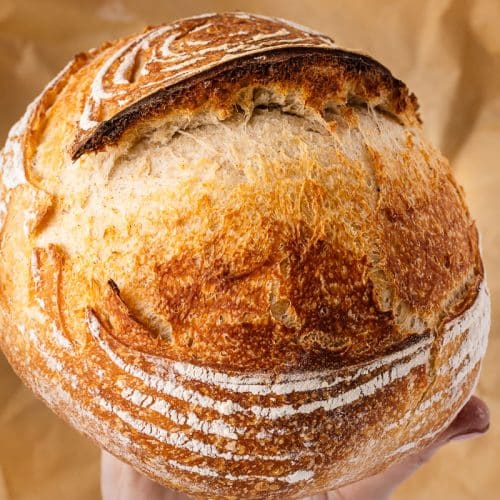
Easy Sourdough Bread Recipe
Learn how to make a perfect loaf with this easy sourdough bread recipe! This step-by-step guide walks you through every stage, from preparing your starter to baking a beautifully golden, crusty loaf. Whether you're a beginner or a seasoned baker, this method ensures a chewy, tangy interior with a crisp, bakery-quality crust. Get ready to fill your kitchen with the irresistible aroma of fresh-baked sourdough!
Equipment
- Silicone Sling
Ingredients
Levain:
- 50 g White flour 11.5%
- 50 g Water
- 10 g Sourdough Starter 100% hydration (which means you fed it equal parts of flour and water)
Autolyse:
- 500 g White Flour
- 300 g Water
Prior to Baking:
- Rice Flour
Instructions
Prepare the Levain (12 hours before baking)
- In a small bowl, mix 50g white flour, 50g water, and 10g active sourdough starter.
- Stir well until fully combined.
- Cover loosely and let it sit at room temperature for 12 hours, until bubbly and active.
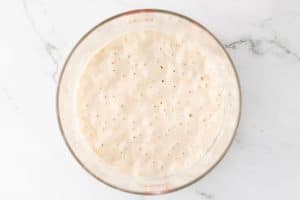
Autolyse the Dough (30 minutes before levain is ready)
- In a large mixing bowl, combine 500g white flour and 300g water.
- Mix until just combined; the dough will be rough and shaggy.
- Cover and let it rest for 30 minutes to allow the flour to hydrate.

Mix the Dough
- To the autolysed dough, add 15g water, 10g salt, and the ripe levain.
- Using wet hands, squeeze and mix until everything is evenly incorporated.
- Continue mixing until the dough forms a sticky but firm mass.
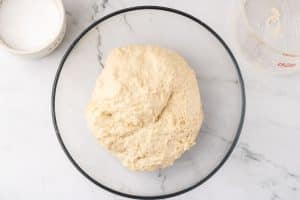
- If the dough feels too dry, add an additional 15g water and continue mixing.
Stretch and Fold (4-6 minutes total)
- Perform a series of stretches and folds by taking the dough into your hands and folding it in half. Then rotate the dough 90 degrees, stretch it, and fold it half again.
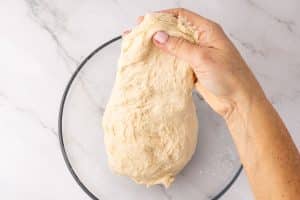
- Continue this process for 4-6 minutes until the dough becomes stronger.
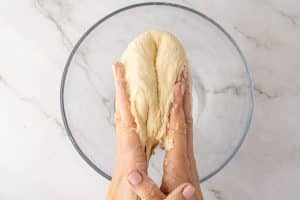
- Set a timer for 30 minutes.
Bulk Fermentation (4 hours total)
- After 30 minutes, do another set of stretches and folds, but once on each 90° rotation, not for 4-6 minutes as you previously did. Repeat these stretches and folds two to three more times, with 30 minutes between each. After the third stretch and fold, you can stop if the dough has more of a domed appearance, is harder to stretch, and feels thicker. If it is still a little slack, wait 30 minutes and do one more set of stretches and folds.
- When done with the 2-3 stretches and folds, let the dough rest for the remaining 2 hours 30 minutes without disturbing it.
- You will know your dough has finished its bulk fermenting if it has risen approximately 30%. You may see bubbles on the top and sides.
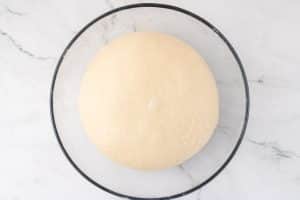
- At room temperature (~70°F/21°C), bulk fermentation typically takes 4-6 hours but can vary based on temperature and starter activity. If in doubt, it’s better to underproof slightly than overproof—underproofed dough can still rise in the oven, but overproofed dough may collapse.
Preshaping the Dough
- Lightly flour your work surface.
- Using your hands, shape the dough into a rough boule (round shape).
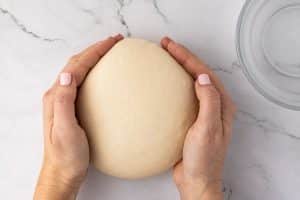
- Let it rest uncovered for 30 minutes to relax the gluten.
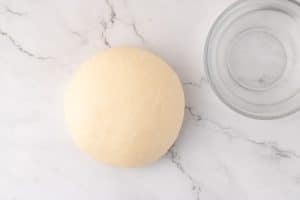
Final Shaping & Proofing (Overnight in the Refrigerator)
- Prepare a proofing basket (or a bowl lined with a floured towel) by sprinkling rice flour in the bowl.
- Turn it over on a lightly floured counter.
- Use both hands to gently flatten it slightly to form a disk or a loose 4-sided star.
- Turn down the top half of the dough to the middle.
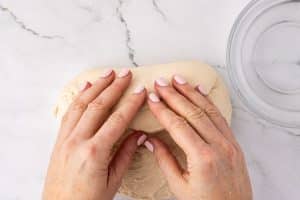
- Pull the bottom half to the middle and push to adhere.

- Fold both sides in and pinch the dough to adhere it.
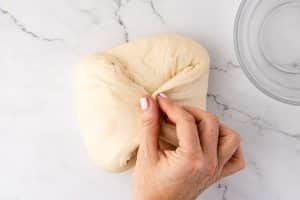
- Turn the dough back over so that the seam is on the counter.
- You can shape the boule using a bowl scraper or your hands. You can see a video showing the process of using a bowl scraper by following the QR code in the notes below.
- If you would rather use your hands, lightly flour your work surface and your hands. Be careful not to use too much flour, as you still want some friction to build tension in the dough.
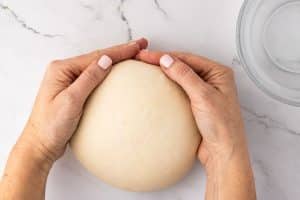
- Next, begin tightening the shape by cupping your hands around the dough.
- Gently pull the dough toward you while rotating slightly, using the pinky sides of your hands to create tension on the surface.
- Continue this pulling and rotating motion until the dough forms a smooth, round shape with a taut surface. If the dough sticks to the counter, lightly dust your hands with flour, but avoid flouring the bottom of the dough too much, as friction helps create the tension needed for a good rise.
- Repeat this process of rotating the dough and dragging it toward you until it holds itself in a nice round boule.
- Once formed into a tight boule, place it into the proofing basket, seam side up.
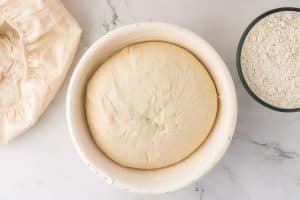
- Cover the banneton with plastic wrap or a reusable silicon cover, or put it in a zip-lock bag and refrigerate for 18 hours for slow fermentation and flavor development. You can refrigerate the dough for up to 48 hours. The longer you leave it proofing, the more sour the bread will be.
Preheating & Baking
- Preheat your oven to 450°F (232°C) with a Dutch oven inside. Once it reaches 450°F (232°C), set your timer for 30 minutes.
- Carefully remove the dough from the refrigerator and place it on a long sheet of parchment paper or a bread sling. I prefer a bread sling.
- Score the dough with a lame, sharp knife,, or razor blade to allow expansion.

- Once the 30 minutes timer goes off, transfer the dough into the hot Dutch oven.
- Bake covered for 20 minutes, then uncover and bake for another 15-35 minutes until golden brown. Every oven is different, which is why there is a 10-minute variation in the final baking time. The bread is done when it reaches an internal temperature of 200-210°F (93-99°C).
Notes
How to shape a boule using a bowl scraper.


Nutrition
Serving: 1sliceCalories: 155kcalCarbohydrates: 33gProtein: 6gFat: 1gSaturated Fat: 0.01gPolyunsaturated Fat: 0.02gMonounsaturated Fat: 0.003gSodium: 2mgPotassium: 50mgFiber: 4gSugar: 0.01gCalcium: 29mgIron: 1mg
Well, what did you think?Please rate this recipe here! It helps other readers and also helps to support our site.